|
Lost Buildings of Wolverhampton |
|
Shops at the southern end
of Worcester Street
By Bev Parker
The southern part of Worcester Street
changed dramatically in May 2006 when the old run-down,
derelict shops were demolished. Over the years, Worcester
Street’s fortunes have declined. It was once a thriving
shopping area with a large number of popular shops selling a
wide range of commodities.
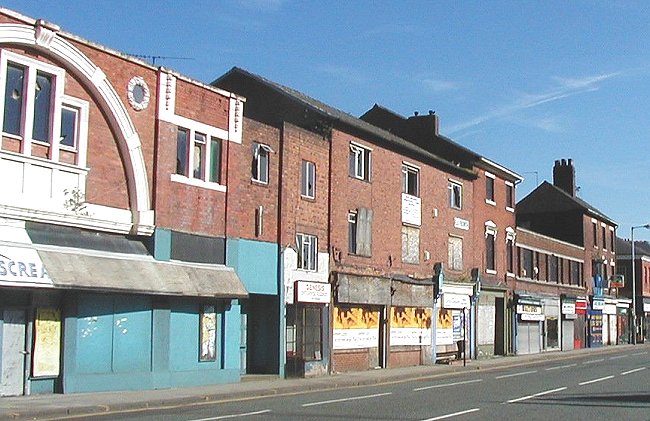
The derelict shops in 2001.
There has been a slow, steady, decline
in trade in the area since the late 1980s, mainly due to
changes in people’s shopping habits. Over the years,
Worcester Street, particularly the southern section, has
become an area which people hardly ever visit, they just
pass through on their way to and from the City centre. This
feeling of isolation has been acute since the closing of the
shops, and their subsequent demolition. It should end with
the completion of the youth zone project which replaces the
shops. |
|

The area in the early 1900s. |
It is an area that had no grand buildings,
the most spectacular being the Scala Cinema. As a result it
wasn’t popular with photographers and so comparatively few
photos seem to have been taken. Although the shops had little
architectural merit, they once provided a great service to the
local community, and many of them will be fondly remembered for
years to come.
The area grew-up as a mixture of factories
and shops. As the factories closed, they were replaced by more
shops, so that by the time the Picturedrome (later the Scala)
opened at the end of 1913, all of the factories had gone.
One of the factories was Highmoor Cycles on
the corner of Church Street and Worcester Street, sometimes
listed as being in Worcester Street, and other times in Church
Street. |
|
From an 1897 trade
directory:
The Highmoor Cycle
Co., manufacturers of high-grade cycles, in Church
Street.
One of the most prosperous of the
recently-established concerns in connection with the
cycle manufacturing industry in Wolverhampton, is that
known as " The Highmoor Cycle Co.," whose works, now in
course of large extension, are situated in Church
Street. This business has rapidly assumed an important
position in the trade, a result that establishes
convincing proof of the first-class character of the
cycles produced. In the works now being erected,
employment will be afforded for nearly 100 hands, and it
is evident that the Company intend to spare no expense
in the equipment of the same to ensure the very best
manufacturing facilities. The gentlemen at the head of
affairs are Mr. S. T. Thomas and Mr. I. Elliott, and up
to now they have every reason to be proud of the success
that has attended their able and enterprising
administration. The Highmoor cycles for ladies and
gentlemen combine all the latest improvements, and are
absolutely unsurpassed for speed, strength, light
running, and uniformly high-class workmanship and
finish. This Company aim to place only the most reliable
" mounts " on the market, and to this fact they
undoubtedly owe their rapidly widening connection.
Repairs are speedily executed, and all the latest
pattern component parts are supplied at lowest prices.
There is no doubt that the " Highmoor " machines will
continue to advance in popularity amongst all riders who
value quality before cheapness, hence we can safely
predict a large expansion of trade for a business so
ably and enterprisingly conducted. |
|
| Across the road at number 50 Worcester Street stood A. W.
Paddey’s cooperage, and nearby was a garage and workshop
belonging to Emile Medinger, designer and builder of the
Medinger car. Early wirelesses were built and sold by the Radio
Electric Company at numbers 33 and 34, just round the corner
from Temple Street. On the corner of Worcester Street and
Temple Street was Alfred J. Gilmore's hat and hosiery shop. The
following is a description from an 1897 business review:
One of the most popular Hat and Hosiery
establishments in Wolverhampton is that owned by
Mr. Alfred J. Gilmore, situate on the corner of
Worcester Street and Temple Street (see
illustration), and who has also a capital branch
shop at 74 Bilston Street.
|
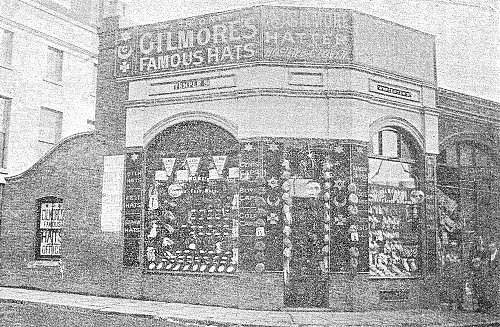
Gilmore's shop on the corner of
Worcester Street and Temple Street. |
|
This business is carried on in a
most smart and energetic manner, and the
proprietor is not only fully alive to
the requirements of the public, but,
moreover, anticipates them with
consummate skill, which at once stamps
this as one of the smartest, best, and
cheapest houses in the town for hats and
hosiery of every description. |
Mr. Gilmore has justly earned the name of
"the people's hatter and hosier;" his "Star",
"Crescent", and "Cross" speciality having had a
tremendous sale, and thousands of which are now
worn.
Mr. Gilmore selects his stock with discretion
and care from the best sources, in a manner
which at once proves his intimate knowledge of
the business. Large stock is always maintained,
while an inspection of them is well worth
making. The business is bound to continue to be
a popular and progressive one. |
|
In the early years of the twentieth
century the shops included:
| East
Side: |
|
|
|
number |
name |
|
| 23 |
A. H. Cole |
newsagent and tobacconist |
| 24a |
Nelson & English |
butcher |
| 25 |
H. Tilley |
greengrocer |
| 27 |
F. Winwood |
draper |
| 27 |
A. Mills |
confectioner |
| 40 |
C. E. Gaunt |
hairdresser |
| 41 |
C. & H. Hallmark |
fishmonger |
| West
Side: |
|
|
| number |
name |
|
| 43 |
Gibbons |
newsagent |
| 44 |
J. Tandy |
greengrocer |
| 53 |
J. Perkins |
confectioner |
| 54 |
H. G. Roberts |
pork butcher |
| 61 |
Southan Brothers |
tailor |
| 64 |
Miss Fox |
dressmaker |
| In 1912 Emile Medinger, one of Sunbeam's racing
drivers, who won the Coupe de L’Auto that year,
decided to produce cycle cars and acquired a
premises in this part of Worcester Street. He
designed a two-stroke engine for the car which
developed 16hp. and also a four-stroke, four
cylinder engine. He occupied his Worcester Street
premises until the summer of 1913 when he moved to
Teddington, Middlesex. It is likely that his
premises was on the side of the yard where the
Picturedrome Cinema was built later that year. This
may have influenced his decision to leave
Wolverhampton. |
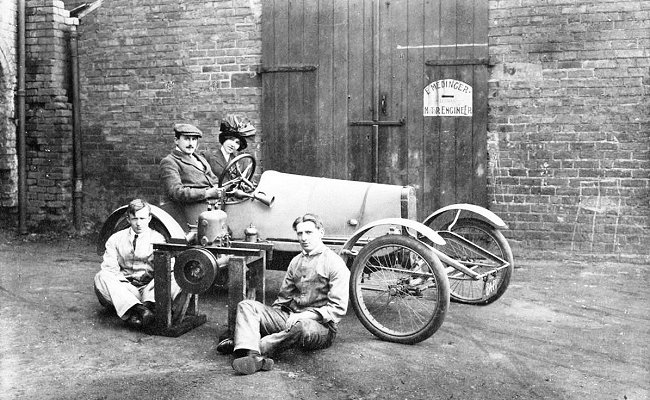
Emile Medinger and his wife
seated in one of his cyclecars outside his Worcester
Street premises. In front is one of his two
cylinder, two-stroke engines. Courtesy of
Peter Walford. |
| The Picturedrome Cinema was built on the site of
a large yard, in 1913, by Wolverhampton Picturedromes
Limited, run by F. Evans and G. Lewis. It opened on
Monday 22nd December with a film called 'Dancing
Lessons on Film.' It seated 942 people in the
auditorium and 248 on the balcony. After the First
World War it was purchased by Edgar Hounsell,
proprietor of the Midland Amusements Company and
renamed 'The Scala' with Mr. Hornblow as manager.
In 1920 the cinema was sold again, this time to
Midlands Entertainments Limited, and in the mid
1920s became part of Associated Provincial Picture
Houses who also owned the Queens Cinema and the
Agricultural Hall. In 1925 the cinema was
refurbished, and reopened on 28th September, 1925
with a showing of 'Winning Through' and 'The
Mirage'.
The Scala had a successful life, serving the
local population in the Graiseley and Penn Fields
area until the late 1940s and early 1950s when
visitor numbers fell. It closed in December 1956 and
was converted to a Bingo Hall. The ground floor
became shops.
Wrestling bouts were held there in the
1960s when it became a dance hall and a popular venue
for fans of rock 'n' roll music.
Some of the area's earliest groups including Tommy
Burton's Combo, Dixie Dean's Combo, Clive Lee &
Phantoms, and the original Black Diamonds regularly
played there along with some of the national stars
including Billy Fury, Nelson Keen and Vince Eagar.
The dance hall continued to operate for many
years, and became a night club, but in 1999 the
building lost its roof tiles which were stolen. A
group of workmen appeared, seemingly to repair the
roof. They removed all of the tiles and made off
with them. The building then suffered from water
damage, as rain poured-in. Anything inside that was
valuable also soon disappeared, and the building
began to decay. It was finally demolished along with
the surrounding shops in 2006, but the facade was
saved with the intention of incorporating it in a
new hotel development on the site, which never
happened, In October 2011 the decision was taken to
demolish the facade, which soon disappeared. |
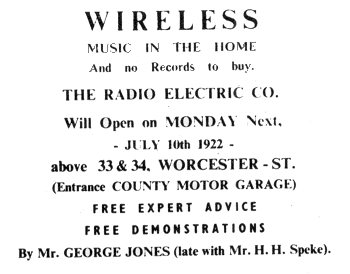 |
In July 1922 the Radio Electric Company opened
for business at numbers 33 and 34 on the eastern side
of the street.
The Radio Electric Company was founded by George
Jones, Secretary of the Wireless Society who had
the call sign 2WB. He had previously worked at Mr.
Speke's model, toys, and book shop in King Street.
When he started the business he relinquished his
secretarial duties due to pressure of work. Within
six months the business had moved to a shop in St.
John's Street. |
| The company built cheap crystal sets, which
most people could afford. One of their popular
models sold for seven shillings and six pence. |
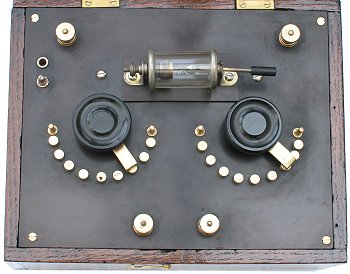
A Radio Electric Company
crystal set. |
| In the mid 1930s the shops included: |
| East
Side: |
|
|
|
number |
name |
|
| 23 and 24 |
The Spot |
draper |
| 25 |
H. V. Jones |
electrical engineer |
| 25a |
Valeting Service Company |
cleaners |
| 27 |
F. Robinson |
furniture dealer |
| 27a |
C. Hooper |
greengrocer |
| 29a |
C. Harper |
poultry dealer |
| 30 |
W. Phillips |
ironmonger |
| 30a |
T. Porter |
butcher |
| 31a |
A. Harris & Cresswell |
printers |
| 32 |
G. F. Dawson |
antique dealer |
| 33 |
W. Harry |
confectioner |
| 34 |
W. Hart |
cobbler |
| 38 |
S. R. Hicks |
greengrocer |
| 40 |
R. Wright |
general dealer |
| West
Side: |
|
|
|
number |
name |
|
| 45 |
City Stores |
general dealer |
| 46 |
N. H. Dunn |
grocer |
| 47 |
H. Fellows |
chemist |
| 49 |
Scala |
cinema |
| 49 |
W. A. Loveday |
dancing teacher |
| 53 |
E. E. Joyce |
newsagent |
| 55a |
J. W. Lewis |
tailor |
| 56 |
Stantons |
baker |
| 57 |
R. C. Hall |
butcher |
| 57 |
R. H. Robshaw |
confectioner |
| 60 |
K. & S. Pratt Limited |
grocer |
| 62 |
G. T. Parsons |
confectioner |
| 63 |
P. Kirner |
jeweller |
| 64 |
Pratt (Wolverhampton) Limited |
confectioner |
| By the mid 1960s the shops were as follows: |
| East
Side: |
|
|
|
number |
name |
|
| 23 |
Berrymans Limited |
shoe shop |
| 24 |
Rita |
ladies’ outfitter |
| 25 |
G. E. Bird (Wolverhampton) Limited |
watch maker |
| 26 |
G. R. Griffiths |
television dealer |
| 27 |
Parlour Café |
restaurant |
| 27a |
F. J. A. Turner |
fishmonger |
| 28 |
F. J. A. Turner |
fish and Chip shop |
| 29 and 30 |
William Phillips (Tools) Limited |
tool merchant |
| 30a |
R. G. Evans |
butcher |
| 30b |
K & M Sandwich Shop |
sandwiches etc. |
| 31b |
Mrs. P. M. Pritchard |
grocer |
| 32 |
Darlington’s (Carpets) Limited |
carpet shop |
| 33 |
W. Harry Limited |
tobacconists |
| 34 |
G. Hart |
cobbler |
| 35 |
Turjon Cycle and Radio Depot |
cycles, radios etc. |
| 36 |
Trojan Hardware Limited |
door furniture manufacturer |
| 37 |
Wittfield Sewing Machines Limited |
sewing machine dealer |
| West
Side: |
|
|
|
number |
name |
|
| 49 |
A. Keith Thompson |
grocer |
| 49 |
Ophide & Marten Limited |
hairdresser suppliers |
| 49 |
Ophide & Marten Limited |
Ophide College of Hairdressing Limited |
| 49 |
A. H. Hartland |
hairdresser |
| 49 |
Scala Ballroom |
dance hall |
| 49a |
The Do-It-Yourself Centre |
paper, wallpaper etc. |
| 50 |
P. Hacker |
turf accountant |
| 50 |
Domestic Electrical Rentals Limited |
television rentals |
| 50a |
His Casuals |
gents outfitters |
| 51 |
Midland Hire Services Limited |
car hire |
| 52 |
Worcester Street Post Office |
post office |
| 53 |
Counties Libraries Limited |
newsagents |
| 54 |
Palin’s |
boot and shoe shop |
| 55 |
G. Greenstone Limited |
wallpaper and paint etc. |
| 55 |
Waltons |
electronic components |
| 55a |
Bert Williams |
sports outfitters |
| 55b |
R. M. Fullard |
confectioner |
| 56 |
B. Hodson |
betting shop |
| 57 |
A. B. Donson & Son Limited |
ironmonger |
| 58 |
T. A. Collins Limited |
shoe shop |
| 60 |
Anglo-Continental Shoe Repairs |
cobbler |
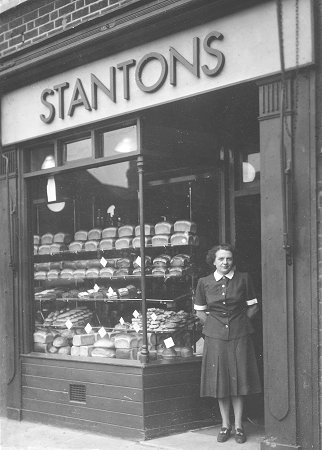 |
Local bakers S. J. Stanton had a branch at number 56
Worcester Street from the mid 1930s until the mid 1950s.
The firm was a well known supplier of bread and cakes.
Next door was A. B. Donson & Son Limited, a wonderful
ironmonger's shop which stocked a vast range of tools
and accessories, and would quickly get anything to
order. Donsons opened their shop in 1932. It was handed
down to the son of the founder, then his grandson, and
remained in business until the late 1980s. By the mid 1960s there was a wonderful variety of
shops and services in this part of Worcester Street
which could rival many parts of today's City centre. All
of the shops offered a first-class, friendly service
with a smile. County Libraries Limited stocked a wide
range of newspapers and magazines, and were happy to get
anything on order, be it a one-off or regular order.
Greenstones carried a wide range of paints and
wallpapers, as did the Do-It-Yourself Centre. |
| In about
1965 Waltons moved into number 55 and offered a
wonderful Aladdin’s cave of electronic components,
suitable for any enthusiast. There were many pieces of
electronic equipment on display, some new, but mainly
old; and of course government surplus and ex-W.D.
equipment were commonplace in those days. There was also
a fair share of “junk” equipment, either not working or
incomplete, that could form the basis of a new project.
Valves, transistors and general components could be
purchased at good prices, as could such things as reel
to reel tape and tools. The staff were always friendly
and helpful, and Jack Dennes could be relied upon to
make any visit a happy and enjoyable occasion. By this time integrated circuits were starting to
appear and Walton’s became one of the main stockists in
the area. They were always willing to order any item
that wasn’t in stock and continued to offer a first
class service. They could get almost anything. I built
my first television set in about 1967 and wanted a
plastic front from a commercially available receiver. I
had a brief word with Jack about it and one week later
it had arrived and was awaiting collection.
|

Donsons at number 57. |
|
I got to know the people at the shop extremely well, and
sometimes helped out by repairing odd pieces of test
equipment, which would later go on sale. Waltons were
well known in the area and customers often travelled
from all across the Black Country and parts of
Shropshire. I’m sure many people will still remember
their telephone number: Wolverhampton 22039.
|
| The Wolverhampton branch of DER was ably managed by
Geoff Latham who had a sizeable staff for such a small
television rental shop, including engineers: Paul Barnfield, Robert Bloor, Phil
Ceney, Harry Dougal, Mick Edwards, Neville Jones, Ken
Harris, Brian Maddox, and Graham Mills.
The store keeper
was Vic Lawley, and Ron Britain erected TV aerials. There were also receptionists,
and representatives. Like the other
shops they offered a first rate service, and were well
respected.
The photograph opposite shows a DER colour television
based on a Thorn 2000 receiver. This British design was
the first fully transistorised colour television
receiver in the world.
|
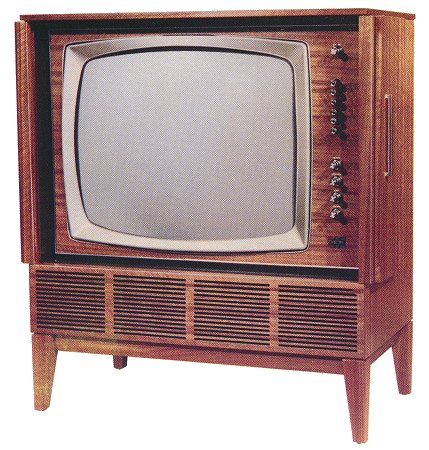 |
|

An advert from the 1960s. |
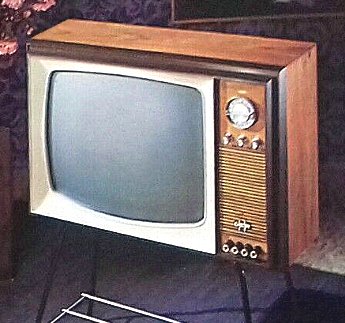
A model 209 dual
standard, 19 inch monochrome receiver.
From a DER advert. |
| |
| A
model 241 dual standard, 23
inch monochrome receiver.
From a DER advert. |
|
|

A letterhead from the late 1960s.


| It's hard to imagine today that such a wide variety
of shops could be found at the southern end of Worcester
Street, selling a fantastic range of products and
services. |
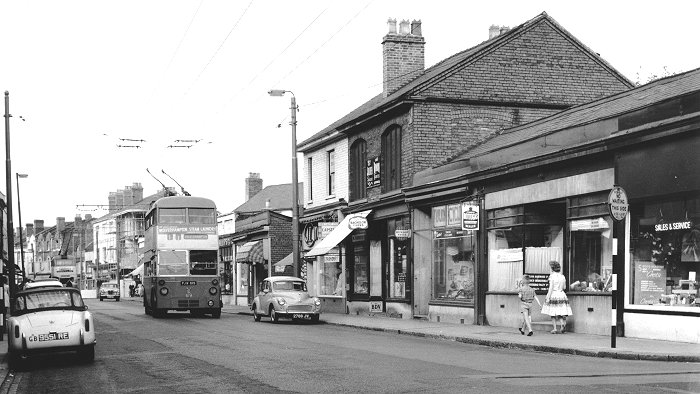
The east side of the street in the 1960s
Courtesy of John Hughes.
|
| Views of the shops from 2001 |
 |
The view from the southern end of the
site, looking towards town. In the 1950s and 1960s the building
on the left was occupied by many businesses including Prestcold
(Midlands) Limited, fridge manufacturers; the Scottish Legal
Life Assurance Society; Ophide College of Hairdressing Limited;
and A. H. Hartland, hairdresser. |
|

Another view of the building with the
derelict Do-It-Yourself Centre on the right.
|
|

A final view of the southern end of the empty
shops with the old Scala Cinema on the right. |

The old Scala with the nightclub and
dancehall entrance on the left, and far right, with what
remained of the DER shop in the centre. |

Another view of the Scala. The door in the
centre was the entrance to DER's shop which had the two large
windows on the right. |
|

The Scala and the derelict shops to the
north.
|
| Next door to the Scala was Genesis
records shop which had earlier been occupied by a car hire firm. |
 |

Another view of Genesis Records with the old post
office in the centre, and newsagents Counties Libraries Limited, on the
right. |
|

The same shops as above with what used to
be Palin's cobblers on the right.
|
 |
The shop in the centre was once G.
Greenstone's decorating shop which sold paint and wallpaper etc. |
|
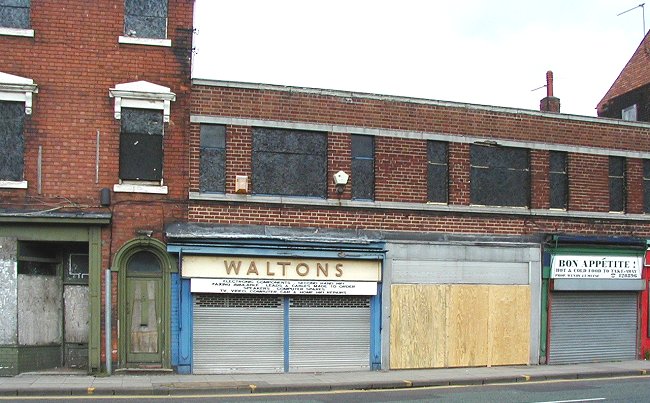
In the centre at number 55 was Waltons' wonderful
electronic components shop. |
|

A close-up view of Waltons. |
|

Another view of Waltons with the remaining shops
on the right. |
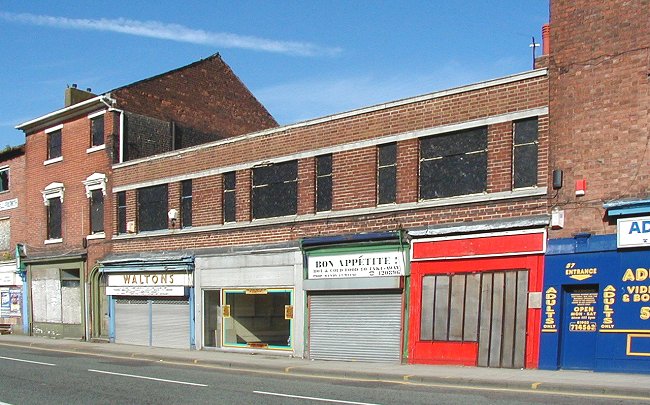
Next door to Waltons, to the right was Bert
Williams' sports shop, R. M. Fullard confectionery, and B. Hodson's
betting shop. |
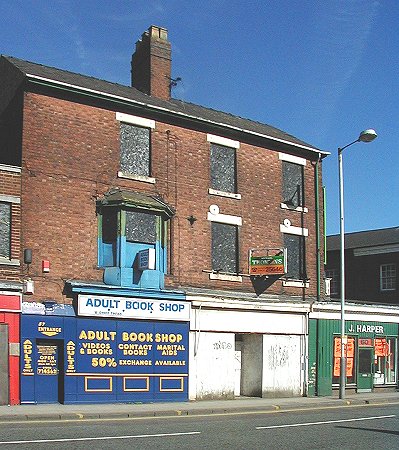 |
The Adult Book Shop on the left was
for many years occupied by the marvellous ironmongers, A. B.
Donson & Son Limited. In the centre was a shoe shop run by T. A.
Collins Limited. |

At number 60 was J. Harper's well known ropes,
nets, twines, tarpaulin and fixings shop which moved round the corner to
Temple Street. It had previously been a cobbler's shop occupied by
Anglo-Continental Shoe Repairs. |
|

A final view of the northern end of the shops. |
| Views of the southern end of
School Street, and behind the Worcester Street shops |

The view round the corner at the southern
end of School Street. In the 1960s Grant's Leather Emporium was
occupied by Roneo Limited, manufacturers of office machinery. On
the right was Esso Kitchens who supplied kitchen equipment, and
later a television repair shop. Next right was the office of
Stanley M. Jones, auctioneer. |
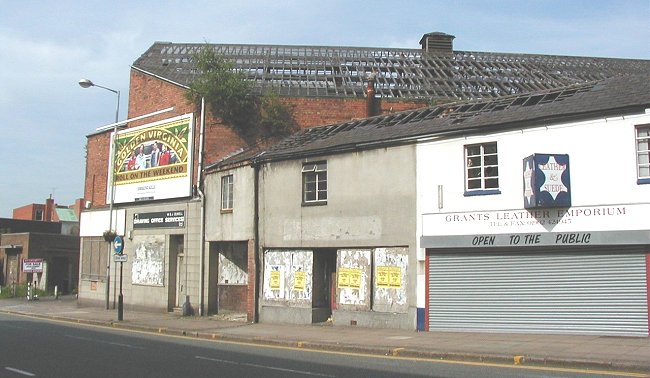
The other shops to the left. On the corner
of the car park entrance was Wolverhampton School of Motoring,
with advertising agents Goddard Watts Limited to the right, and
Burroughs adding machines shop in the centre. In the background
is the old Scala building missing its roof tiles. Roof tiles had
also been stolen from some of the shops. |
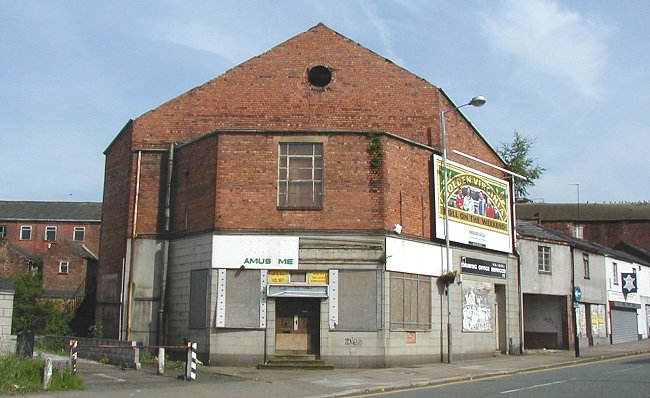
On the left was a car park, with
Wolverhampton School of Motoring on the corner. It was later a
bank, a branch of Barclays as I remember, and later an amusement
arcade. |

Looking into the car park behind the
Worcester Street shops. The part on the left was occupied by a
small petrol filling station called Auto Scooter Services, and
also Quality Petrol Station. |
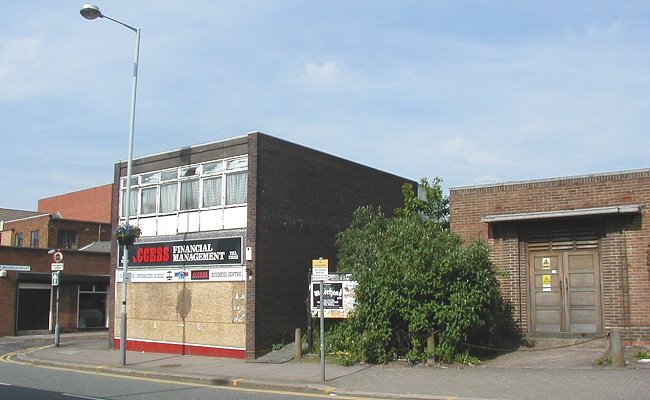
The remaining buildings with Little
Brickkiln Street on the left, Access Financial Management in the
centre, and an electricity sub-station on the right. |
|
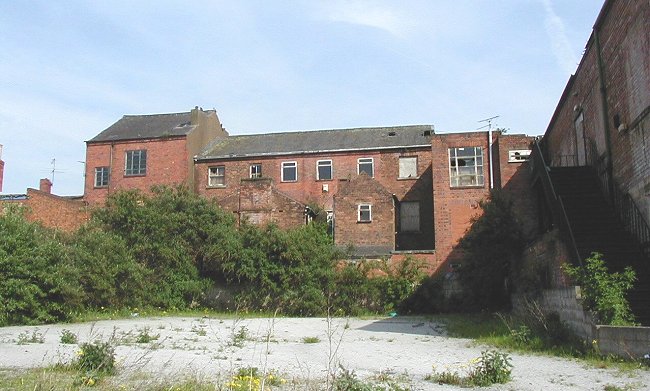
The car park with the backs of the
Worcester Street Shops behind, and the Scala on the right. |
|
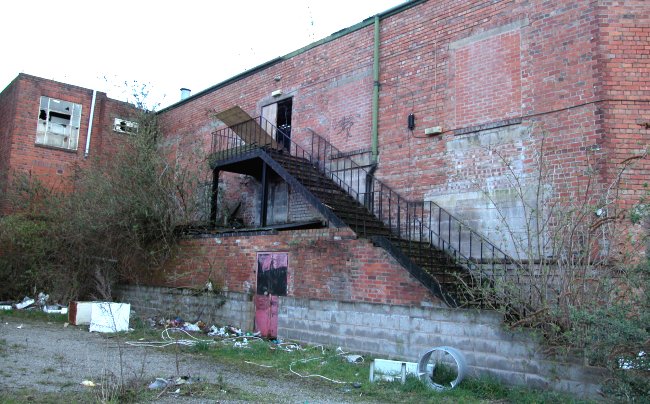
The side of the Scala showing the upstairs
fire escape after the doors had been stolen. |
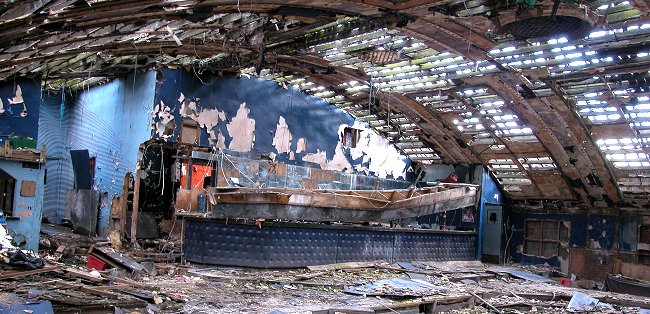
The inside of the Scala as seen through
the open fire escape door. The building had been badly water
damaged after the stealing of the roof tiles. Even some of the
floorboards had been taken. |
|
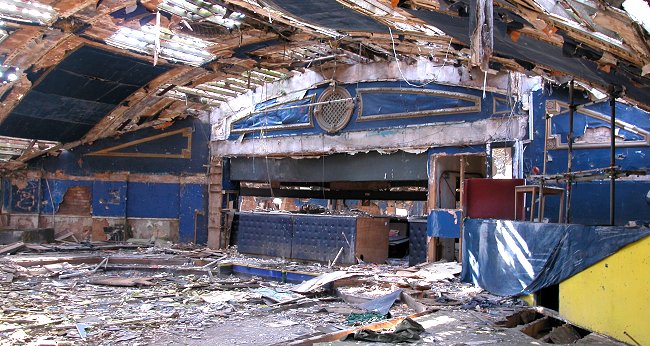
Another sad sight, the other end of the
Scala, also seen through the open doorway. |
|
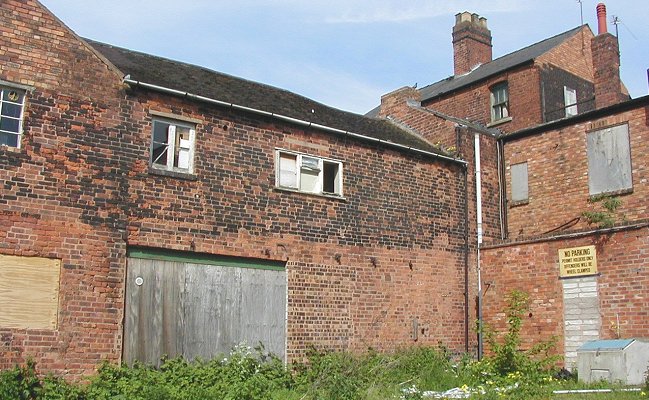
Part of the yard behind the Worcester
Street shops that was accessible from Little Brickkiln Street. |
|

The centre of the yard behind numbers 55b
and 56 Worcester Street. |

The far part of the yard behind Walton's
shop. The hole in the wall of the outbuilding in the centre was
made by people sleeping rough inside. |
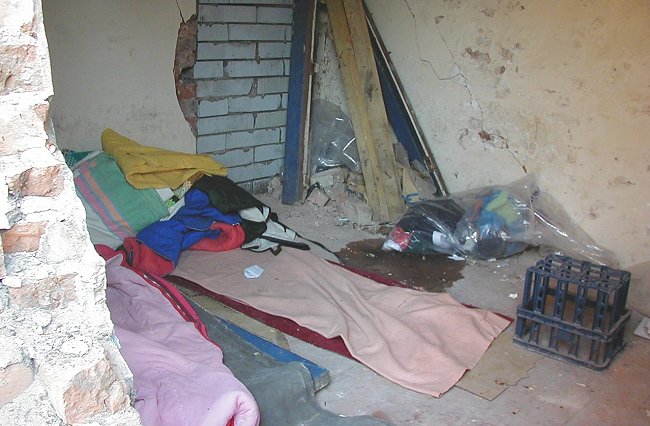
The inside of the small outbuilding as
seen through the hole in the wall. It's the first time I had
come across this kind of thing. |
 |
Return to
the
previous page |
|